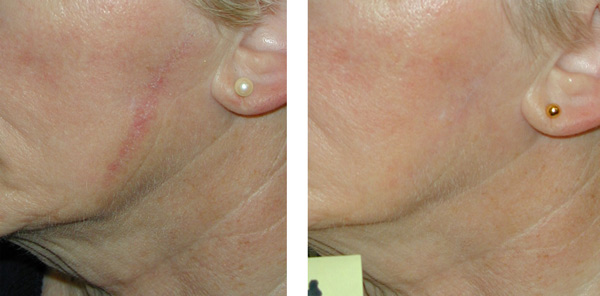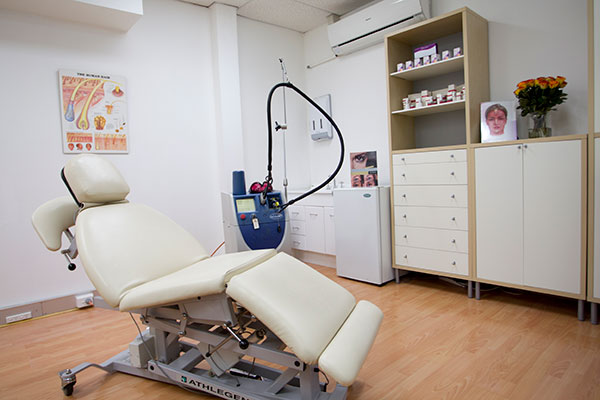Reasons for development of scarring may include bodily acne, thermal or traumatic injury, body piercing and post surgical procedures.
The way in which scarring forms can be related to genetic predisposition, age, as well as race. Although it is impossible to completely transform the scar back to usual skin appearance, we can help to soften, flatten and improve the appearance of scarring over time.

Types of Scars
Hypertrophic Scars
Hypertrophic Scars
Hypertrophic scars are formed during wound healing when the rate of collagen production exceeds the rate of collagen degradation, thereby resulting in an increased amount of tissue over the wound. This results in a raised, pink appearance. The scar may continue to thicken over 6 months, and even though it may improve over time, it may not completely flatten on its own.
Keloid Scars
Keloid Scars
Keloid scars are similar to Hypertrophic scars, as they are also the result of an overproduction of collagen during wound healing. However with Keloid scarring, the increase in tissue exceeds the boundaries of the underlying wound, thereby creating a raised scar with an increased circumference.
Stretch Marks / Striae
Stretch Marks / Striae
Striae or Stretch Marks are often formed during rapid stretching of the skin, such as during growth, weight gain and pregnancy. The pressure exerted on the skin causes tearing of the underlying dermis. The rate of skin cell production exceeds the rate of collagen production, resulting in a pink/purple, slightly atrophic scar. Genetic predisposition, hormonal influences, as well as diet and potentially fitness all play a role in the skin’s ability to withstand stretching forces. Although the stretch marks may lighten over time, they will not completely repair.
Post-traumatic Hyperpigmentation
Post-Traumatic Hyperpigmentation
Post-traumatic Hyperpigmentation is a result of disruption to the skin, which has resulted in inflammation. The inflammatory cascade stimulates the production of melanin within the epidermal-dermal junction, thereby resulting in patchy, dark pigmentation. This is often a result of cystic acne lesions, and more commonly seen in dark skin types. Due to the depth of this type of pigmentation, it is nearly impossible to remove, however may lighten over time with appropriate treatment.
Treatments
Although we cannot remove scars, stretch marks or hyperpigmentation, we can help to improve the appearance over time. Treatment requires ongoing, diligent use of medical grade topical solutions, as well as clinical chemical peels.
Laser Treatments
Stretch marks and body scars are best to treat when they are red in colour. Lasers are very effective in removing redness and improving the overall appearance of stretch marks.
As we mentioned earlier it is very difficult to remove stretch marks, although significantly improving red stretch marks is quite achievable using lasers such as the Excel V. Once stretch marks lose their red color, laser treatments offer much less improvement.
Chemical Peels
Dermally Active Vitamin A Peels may be used to resurface scarring and promote collagen production, offering benefits for all types of scarring, stretch marks and hyperpigmentation.
Medium Depth Resurfacing Peels are also beneficial for exfoliating damaged skin cells, promoting reorganisation of the epidermis. This peel may be beneficial for hypertrophic and keloid scarring, by improving the skin texture.
Topical Cosmeceuticals
Topical Vitamin A
Topical Vitamin A is a resurfacing agent used to increase the cellular turnover rate, thereby gradually lifting and exfoliating damaged skin cells, in replacement for new, healthy skin cells. It promotes the regulation of collagen production and offers antioxidant benefits. It is a vital solution for the improvement of all types of bodily scars, stretch marks and hyperpigmentation.
Topical growth factors and peptides are used to promote healing, offering wound repair and remodelling. Growth factors are stimulated by the body’s immune system in response to signals for repair, and may be used to promote skin cell proliferation and collagen production. This offers benefits for all types of scarring, stretch marks and hyperpigmentation.
Alpha and Beta Hydroxy Acids
Alpha and Beta Hydroxy Acids promote exfoliation of the epidermis, boosting cellular turnover.
This helps in removing damaged skin cells, promoting reorganisation of the epidermis, thereby improving skin texture and clarity.
Topical Lightening Agents
Topical lightening agents offer tyrosinase inhibition, thereby regulating melanin production and preventing abnormal deposition of pigment.
This is an essential treatment for Post-traumatic Hyperpigmentation.

